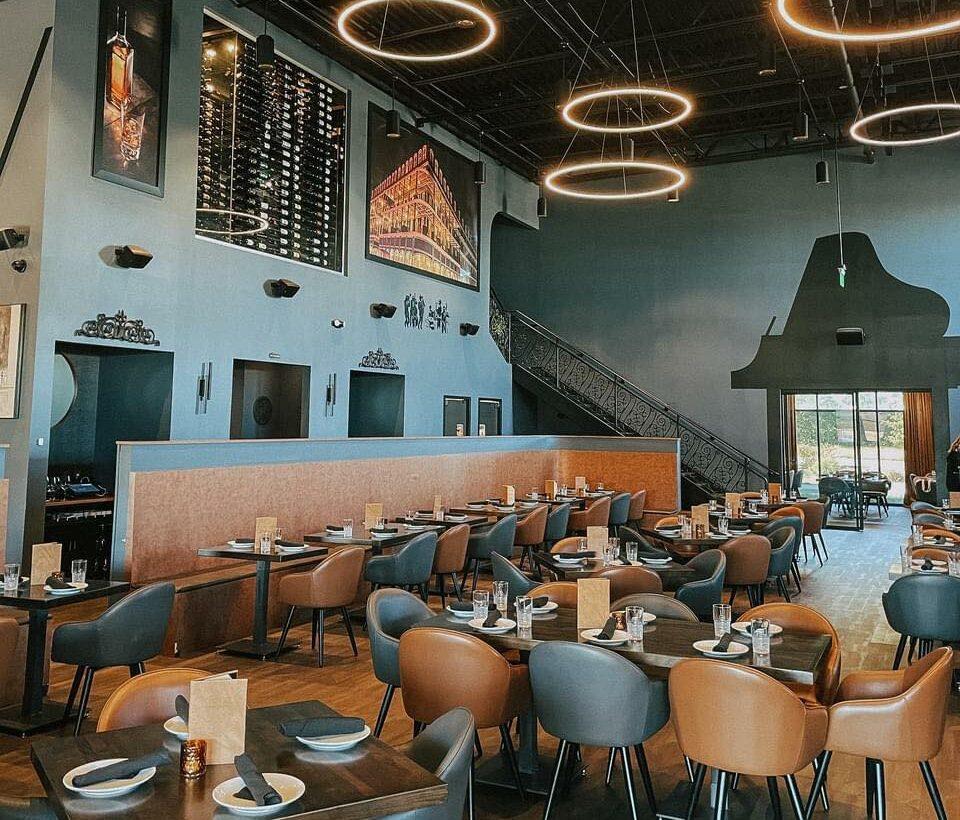Asian Fusion Restaurant: A Distinct Dining Experience in the Heart of Islamabad
Asian Fusion Restaurant: A Distinct Dining Experience in the Heart of Islamabad
Blog Article
Savor Authentic Oriental Food With a Pan-Asian Spin for a Cooking Experience
Starting a cooking journey via authentic Eastern food, enhanced with a Pan-Asian spin, uses an one-of-a-kind possibility to discover the abundant tapestry of tastes that define the area's diverse cooking practices. This experience invites you to relish the charming equilibrium of preferences-- sweet, salted, spicy, and sour-- harmonized by fragrant herbs and spices. Envision the cutting-edge fusion of Thai curry and ramen or the unforeseen delight of sushi burritos. As you ponder these tempting recipes, think about the cultural narratives and historical influences that form them, each bite offering a story waiting to be uncovered.

Exploring Pan-Asian Flavors
In the realm of international gastronomy, Pan-Asian food stands out for its impressive variety and the unified interplay of tastes from various Eastern cultures. This cooking approach commemorates the unique ingredients and rich traditions found across the continent, producing a tapestry of tastes that is both intriguing and enjoyable. Secret to Pan-Asian food is its capacity to stabilize different tastes-- wonderful, salted, spicy, and sour-- while highlighting the freshness and quality of each component.
From the umami-rich soy sauce of Japan to the fiery chili peppers of Thailand, Pan-Asian food offers a considerable palette of tastes. These elements are usually integrated in innovative means, improving recipes with layers of intricacy. For circumstances, making use of fragrant herbs such as lemongrass and cilantro, typical in Vietnamese and Thai food, adds a refreshing brightness to dishes, while the unification of coconut milk delivers a velvety, rich structure.
The emphasis on fresh produce and aromatic flavors guarantees that each meal is not only a feast for the preference buds yet likewise for the senses. Pan-Asian food invites diners to get started on a cooking journey, exploring the substantial and varied landscapes of Asian gastronomy with every bite.
Combination Dishes to Try
While Pan-Asian cuisine is celebrated for its typical tastes, the contemporary culinary landscape is increasingly embracing blend meals that mix these traditional components with impacts from other areas. This innovative technique not only honors the rich heritage of Asian cookeries but additionally introduces unique taste experiences that interest modern tastes.
A prime example of such a combination dish is the Korean-Mexican taco, where marinated bulgogi beef is covered in a warm tortilla, covered with kimchi and a zesty gochujang-infused salsa. This mix weds the strong, tasty flavors of Korea with the lively, fresh components of Mexican food. Similarly, sushi burritos have actually gained popularity, amalgamating the fragile artistry of Japanese sushi with the passionate, hand-held convenience of a burrito, usually featuring combination ingredients like tempura shrimp and avocado with a drizzle of wasabi mayo.
One more notable meal is Thai curry ramen, which instills the luscious, aromatic spices of Thai curry into the comforting brew of standard Japanese ramen, developing a harmonious blend that tantalizes the senses. These blend recipes expand beyond mere uniqueness; they represent a culinary dialogue between societies, motivating exploration and innovation worldwide of Pan-Asian food.
Important Active Ingredients and Spices
To really value Pan-Asian food, one should understand the crucial ingredients and spices that create its structure. This varied cooking design attracts from an abundant tapestry of Eastern customs, utilizing a harmonious blend of tastes and appearances. official statement Secret ingredients consist of soy sauce, fish sauce, and oyster sauce, which pass on a savory umami depth important to Oriental meals. Corresponding to these are rice vinegar and mirin, lending a fragile acidity and sweetness.
Aromatic aspects are essential, with ginger, lemongrass, and garlic being ubiquitous throughout different Pan-Asian recipes. These ingredients provide an aromatic base that enhances the intricacy of flavors. Spices such as star anise, cardamom, and cinnamon present heat and personality, resembling impacts from regions like China and India.

Cooking Methods and Tips
Mastering the art of Pan-Asian cuisine calls for knowledge with its distinctive cooking strategies, each contributing to the vibrant tapestry of flavors this cooking practice is commemorated for. Central to these approaches is the stir-fry, a quick cooking technique that preserves the nutritional honesty and vibrant colors of active ingredients. Utilizing a frying pan, the stir-fry technique permits even warmth distribution, necessary for attaining the characteristic appearance and flavor equilibrium of Pan-Asian meals.
An additional essential technique is steaming, specifically common in Chinese food. This mild technique keeps the all-natural tastes and nutrients of active ingredients, making it perfect for fish and shellfish and veggies. Dumplings, a precious staple, usually benefit from steaming, resulting in soft, succulent appearances.
Barbecuing, also indispensable, presents great smoky midsts to meals such as Korean bulgogi or Japanese yakitori (Romantic restaurants Islamabad). This technique frequently involves marinading components, enabling flavors to penetrate deeply before food preparation over an open flame or warm plate
Lastly, mastering the art of stabilizing flavors-- sweet, sour, salty, bitter, and umami-- is vital. Appropriately layering these aspects can elevate a recipe from average to remarkable, providing a complex and pleasing cooking experience that embodies the significance of Pan-Asian food.
Dining Experiences Worldwide
Across click over here the world, Pan-Asian cuisine provides an unequaled eating experience, celebrated for its abundant tapestry of tastes and vibrant presentations. This cooking phenomenon has actually transcended cultural borders, catching the hearts and palates of food fanatics worldwide. In multicultural cities like New York, London, and Sydney, Pan-Asian restaurants act as fusions where culinary customs from Thailand, Japan, China, and beyond assemble, supplying diners with an eclectic mix of dishes that highlight the region's diversity.
The worldwide allure of Pan-Asian food depends on its ability to offer both credibility and technology. Cooks skillfully marry typical active ingredients such as lemongrass, soy sauce, and miso with modern strategies, leading to recipes that are both refreshingly new and acquainted. This fusion enables restaurants to start a culinary trip that values heritage while welcoming modernity.
Additionally, dining experiences are elevated with thoughtfully developed settings that reflect the principles of Pan-Asian aesthetics. From minimalist Japanese-inspired interiors to vibrant Thai-themed spaces, each restaurant uses an unique setting that complements the culinary offerings. Consequently, patrons are not merely taking in a dish but partaking in a cultural experience, making Pan-Asian eating a truly global phenomenon.
Conclusion
The expedition of Pan-Asian cuisine offers a profound understanding of the intricate interaction of flavors and culinary practices across Asia. By welcoming fusion dishes such as Thai curry ramen and sushi burritos, the culinary trip not only highlights the flexibility of typical active ingredients however additionally showcases cutting-edge contemporary strategies. This gastronomic adventure, enriched by crucial spices and cooking techniques, supplies an one-of-a-kind chance to value the cultural diversity and cooking artistry that define Pan-Asian food on a worldwide scale.
Beginning on a culinary journey through genuine Eastern cuisine, improved with a Pan-Asian twist, supplies an one-of-a-kind possibility to explore the abundant tapestry of tastes that specify the region's diverse cooking traditions.In the realm of worldwide gastronomy, Pan-Asian food stands out for its impressive diversity and the unified interplay of flavors from numerous Oriental cultures. Key to Pan-Asian food is its capability to stabilize different flavors-- sweet, salty, spicy, and sour-- while highlighting the quality and quality of each active ingredient.

Report this page